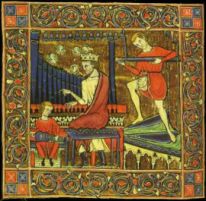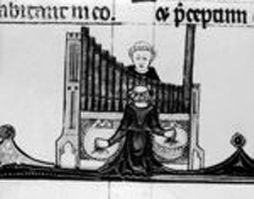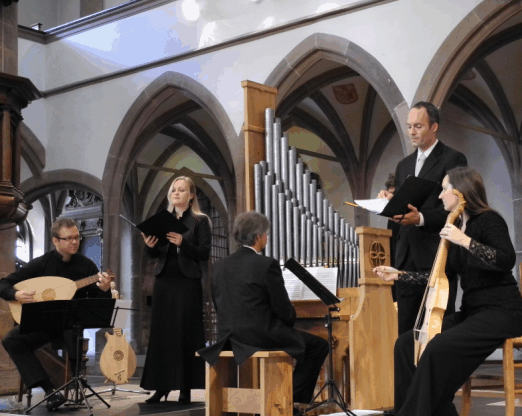 Concert in Peterskirche, Basel, 8th June 2012 (8' and 6' ranks in place)
Concert in Peterskirche, Basel, 8th June 2012 (8' and 6' ranks in place)L to R: Marc Lewon (lute), Eva Kopli (soprano), Brett Leighton (organ),
Nicolas Savoy (tenor), Elizabeth Rumsey (viola d’arco)
 Concert in Peterskirche, Basel, 8th June 2012 (8' and 6' ranks in place)
Concert in Peterskirche, Basel, 8th June 2012 (8' and 6' ranks in place)L to R: Marc Lewon (lute), Eva Kopli (soprano), Brett Leighton (organ),
Nicolas Savoy (tenor), Elizabeth Rumsey (viola d’arco)
Some additional notes for visitors to/participants in the masterclass given on August 6th 2013 for the Early Music Centre, Melbourne/Australia.
As general background it might be of interest to refer to my recent article on this subject in “The Diapason” (May 2013) - http://www.davidrumsey.ch/DIAP0513p20-25.pdf
For sources and bibliographies etc. see http://www.davidrumsey.ch/Bibliography.htm.
Much detail is on my web-site under the “medieval” banner (www.davidrumsey.ch
or http://www.davidrumsey.ch/Medieval.php).
More detail on the van der Putten medieval organ can be found on my web-site, especially at http://www.davidrumsey.ch/Gothic_Organ.pdf
---------------------------------------------
Some Issues
☛ repertoire centred mainly on Robertsbridge-Faenza-Buxheim collections (14th/15th centuries)
☛ appearance: a mix of -
Ange jouant de l’orgue/Angel playing the organ Hugo van der Goes - second from left)
the Norrlanda remnants in Stockholm
Praetorius’ descriptions of Halberstadt (pedals)
Key-widths (iconography)
Rutland and Peterborough Psalters (see below)
La Dame à la licorne tapestry and similar items
etc.
☛ pipe manufacture:
lead cast on sand, hammered, voiced at the pipe mouths (completely open footholes)
☛ wind:
bellows supply, wind pressure and quality
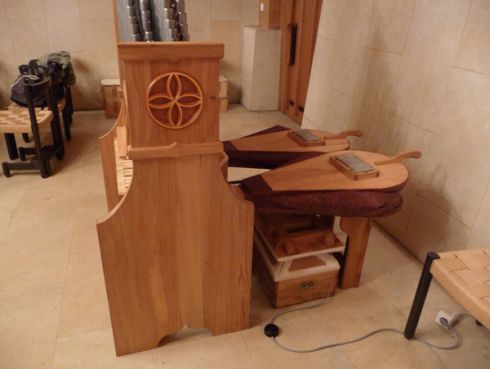
☛ physical attributes:
pedal design, simple suspended action and chest design with two sliders
☛ specification:
two variable-scaled ranks
8' and 6' (after Arnaut de Zwolle - halving diameters on the octave + an addition constant)
one constant-scaled (33 mm) 8' rank interchangeable with the 6'
The Arnaut de Zwolle 8' is always present.
With constant-scaled (“pigeon’s egg”) pipes in façade
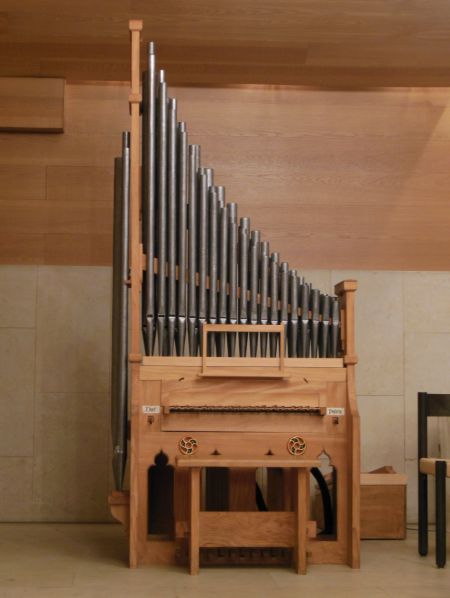
Another entirely constant-scaled instrument (8' + 8' + 6')
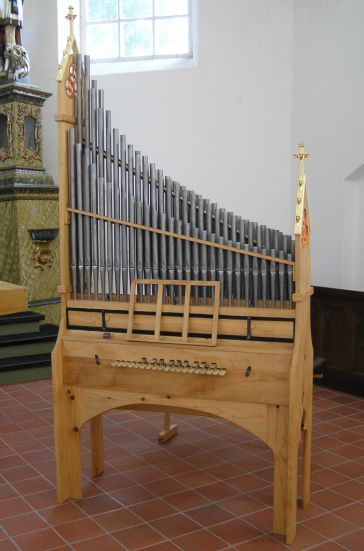
☛ constant-scaled ranks:
Constant scaling: an initial statistical-analytical review of tracts and iconography so far shows that of 140 pre-mid-15th century sources surveyed up to 80% of them could be representing constant scaling.
Detail: http://www.davidrumsey.ch/variable%20scaling%20survey.pdf
Scaling
“This business has up to now caused musicians and good organ makers as many and wonderful thoughts as Mercurius of the philosophers did to the alchemists. It is [now] commonly held that the scaling of pipes cannot and may not be carried out according to the musical proportions; thus some other basis is sought. Some think that the basis of scaling is to be found in solid geometry and not in the musical proportions, and therefore have not been afraid to attack the musical proportions as old and deceptive inventions of Pythagoras; it is much to be desired that this dispute be sorted out.”
Johann Philipp Bendeler in Organopoeia of 1690
... it took European civilization from 8th to 19th centuries to resolve pipe-scaling geometry
☛ metallurgy:
Detail found at www.davidrumsey.ch/Technology.htm
Metallurgy
“there is no doubt that the harmony issuing from an organ whose pipes are made of lead will be much sweeter than that which might come from pipes of tin or some other cruder and harder material.” (Jerome de Moravia 1272-1304 Tractatus de musica quoted by Giovanni Maria Artusi in 1600)
☛ tempering:
a variety of Pythagorean temperaments was required to cover repertoire and scaling paradigms of the era. (a1=466 Hz.)
Current tempering options (all three ranks)
D♭ or C♯
G♭ or F♯
A♭ or G♯
which allows any of the following:
Wolf G♯-E♭ E♭ B♭ F C G D A E B F♯ C♯ G♯
Wolf C♯-A♭ A♭ E♭ B♭ F C G D A E B F♯ C♯
Wolf F♯-D♭ D♭ A♭ E♭ B♭ F C G D A E B F♯
Wolf B-G♭ G♭ D♭ A♭ E♭ B♭ F C G D A E B
E♭/D♯ and B♭/A♯ choices (not yet built) would further increase options to:
Wolf D♯-B♭ B♭ F C G D A E B F♯ C♯ G♯ D♯
Wolf A♯- F F C G D A E B F♯ C♯ G♯ D♯ A♯
see also http://www.davidrumsey.ch/tempering.pdf (You may have to download this and make sure it reads in “Adobe-Reader” - sometimes other readers put numbers in instead of lines).
☛ positions of ranks on the windchest:
the iconography variously gives what is apparently the higher-pitched rank on either the organist or the calcant side.
